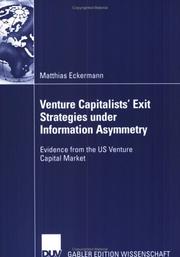| Listing 1 - 2 of 2 |
Sort by
|

ISBN: 3835090186 3835001264 Year: 2006 Publisher: Wiesbaden : Deutscher Universitats-Verlag,
Abstract | Keywords | Export | Availability | Bookmark
 Loading...
Loading...Choose an application
- Reference Manager
- EndNote
- RefWorks (Direct export to RefWorks)
Venture capitalists (VCs) fund ventures with the aim of reaping a capital gain upon exit. Research has identified information asymmetry between inside investors and follow-on investors as a major source of friction. It is thus in the interest of VCs to reduce information asymmetry at exit. Matthias Eckermann analyzes how VCs integrate information efficiency considerations into their exit strategies. He shows that VCs adopt specific strategies to cope with information gaps upon exit in terms of timing, exit vehicles and promotion efforts. On this basis he develops a framework to help VCs to improve profitability through decisive exit strategies.
Capital investments --- Information theory in finance. --- Venture capital --- Forecasting. --- Finance --- Capital expenditures --- Capital improvements --- Capital spending --- Fixed asset expenditures --- Plant and equipment investments --- Plant investments --- Investments --- International economics. --- Finance. --- International Economics. --- Finance, general. --- Funding --- Funds --- Economics --- Currency question --- Economic policy, Foreign --- Economic relations, Foreign --- Economics, International --- Foreign economic policy --- Foreign economic relations --- Interdependence of nations --- International economic policy --- International economics --- New international economic order --- Economic policy --- International relations --- Economic sanctions
Book
ISBN: 1451862830 1462354866 1451908199 9786613828057 1452795568 1283515601 Year: 2006 Publisher: Washington, D.C. : International Monetary Fund,
Abstract | Keywords | Export | Availability | Bookmark
 Loading...
Loading...Choose an application
- Reference Manager
- EndNote
- RefWorks (Direct export to RefWorks)
Tax incentives have been used extensively in the countries of the Eastern Caribbean Currency Union (ECCU) to promote investment. The associated revenue losses are large, and benefits in terms of new investment have been limited, raising doubts about the cost effectiveness of the tax incentive schemes. This paper examines the effects of incentives using the marginal effective tax rate approach (METR), adapting this methodology to the case of a small open economy where the marginal investor is a nonresident. The results show that METRs are high in the region; that there is a large dispersion in the size of METRs across financing source; and that METRs on investment are larger than the overall distortion on capital, with a substantial subsidy to domestic saving. In the presence of tax holidays-the most common incentive scheme in the region-the distortion on capital basically vanishes.
Capital investments -- Caribbean Area. --- Electronic books. -- local. --- Investment tax credit -- Caribbean Area. --- Finance --- Business & Economics --- Financial Management & Planning --- Capital investments --- Investment tax credit --- Capital expenditures --- Capital improvements --- Capital spending --- Fixed asset expenditures --- Plant and equipment investments --- Plant investments --- Depreciation allowances --- Tax credits --- Investments --- Investments: Stocks --- Taxation --- Taxation, Subsidies, and Revenue: General --- Business Taxes and Subsidies --- Pension Funds --- Non-bank Financial Institutions --- Financial Instruments --- Institutional Investors --- Public finance & taxation --- Investment & securities --- Tax holidays --- Tax incentives --- Marginal effective tax rate --- Consumption taxes --- Stocks --- Tax administration and procedure --- Spendings tax --- Antigua and Barbuda
| Listing 1 - 2 of 2 |
Sort by
|

 Search
Search Feedback
Feedback About UniCat
About UniCat  Help
Help News
News